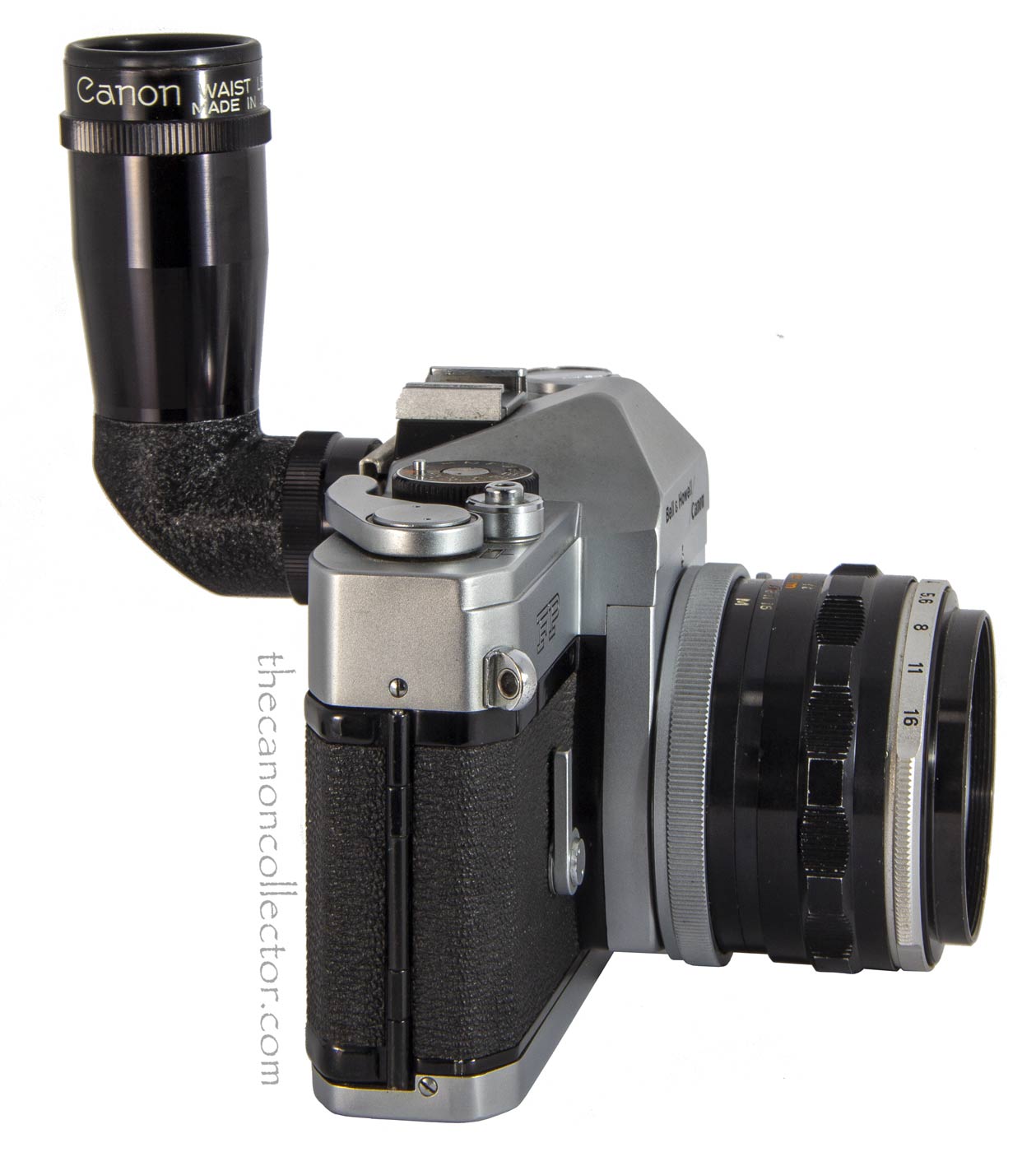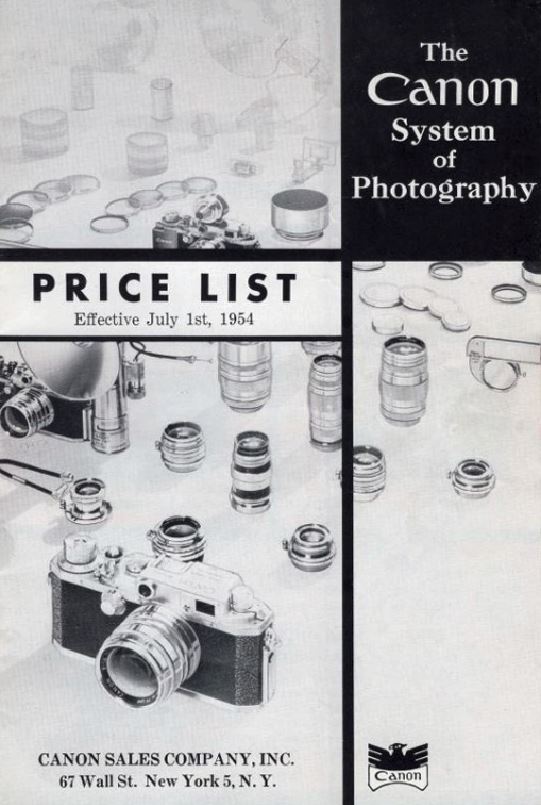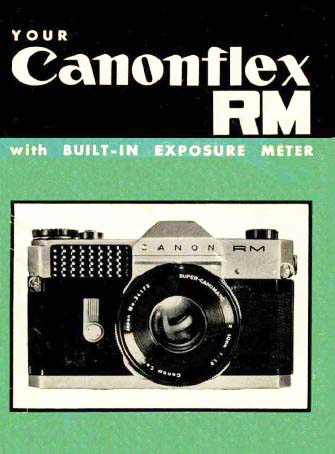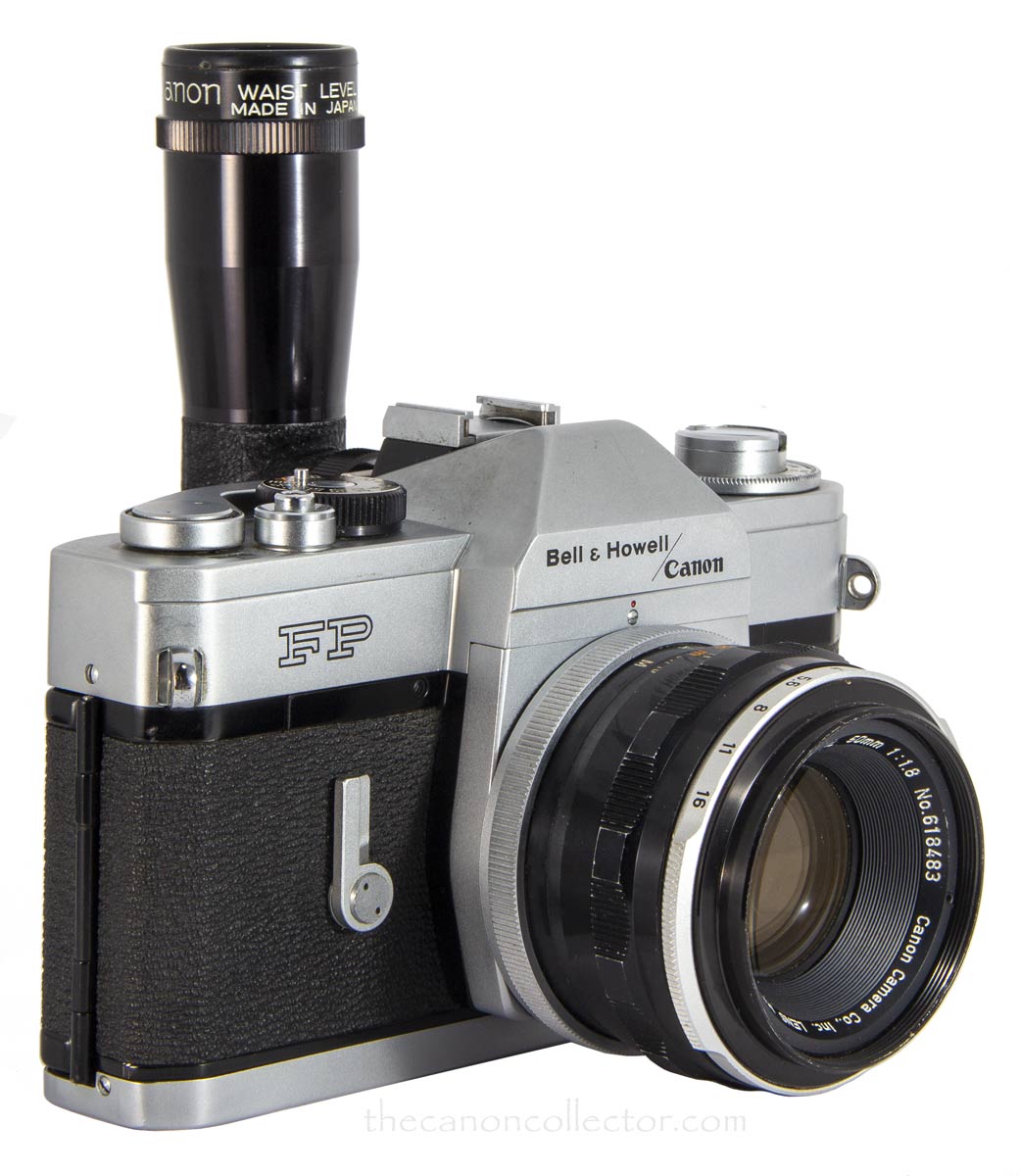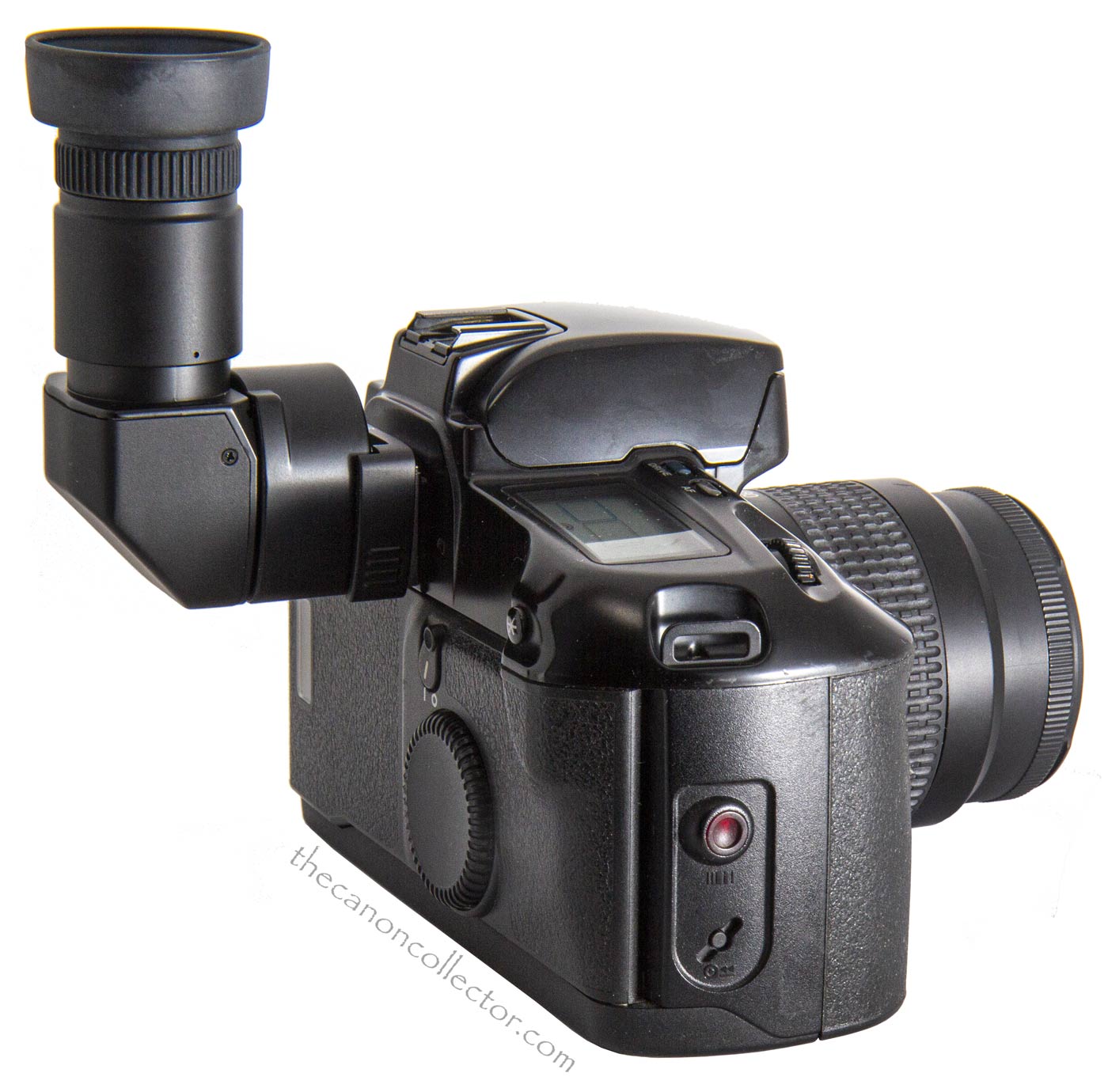Angle Finders / Viewers
Canon angle finders don’t make a big subject for collection: there are only a few models. Not only that but I fear they have been largely ignored. At least I have found almost nothing about them anywhere. However, I have several and this is what I do know.
First, lets be clear what we are talking
about. An angle finder is shown here
on the left. It allows the user to view
the camera’s focusing screen from a 90
degree angle to the eye piece,
sometimes with magnification,
sometimes not.
These things have gone by different names over the decades. In Canon’s early years they were too busy getting the cameras sorted out to worry about consistency. The first reference I can find is in a July 1954 Canon Price List (at the left). The then current cameras listed were the Model IV S2 and the IID 1 so this was some time ago.
At page 19 there is a listing for a “Right Angle Focusing Glass” under the general heading of “Copy Units”. When the camera was mounted on the copy stand, looking straight down, using the viewfinder was difficult.
The same name crops up in a 1962 Canon Catalogue which you can find in the Library. I am assuming that the “Right Angle Focusing Glass” is what we now call an angle finder. There are no pictures to confirm that and I have not seen one in real life, so, for now, we live with assumptions.
The Waist Level Viewer is another creature I have not found in the flesh but, again, I have found references to it in a Canon-Bell & Howell Equipment Catalogue from March 1969, and a reference to it in the Canonflex RM Instruction Manual (which you can find to the right). On page 32 it refers to a Waist Level Viewer under the heading for Microphotography. And this time there is a picture.
I also know it exists because there is a Waist Level Viewer 2. Why have a version 2 unless there is a version 1? As I say, I have not seen one of these but I am on the lookout.
The Waist Level Viewer 2 is a beautifully made device except for the metal clip that attaches to the camera eyepiece. I find it crude compared to the rest of the Viewer.
Now we come to an Angle Finder that I have: the Waist Level Viewer 2. The fact that this one exists reinforces my belief that a first version exists out there somewhere. Mine is in new condition, in the original box with a plastic case and with the Instruction Sheet which is available below.
The Instruction sheet says that the Viewer 2 can be used with the FT, PX, FX, FP and even the Canonflex RP.
The Instruction Sheet for the Waist Level Viewer 2.
The metal clip on the back of the Viewer is stamped metal that grips the camera eyepiece. I fear it is a danger to the camera’s plastic eyepiece. Be careful installing or removing it.
I have taken my viewer apart (I do not recommend this unless you have experience with camera repair) and found that it uses a simple first surface mirror to reflect the light 90 degrees and a couple of lenses to focus the image. The result is that, although the image is upright, it is laterally reversed. A bit confusing but easy to get used to.
The eyepiece tube rotates 360 degrees with detents every 90 degrees. This gives maximum flexibility when setting up a shot. The two situations where this device would be useful are simply variations on the problem of how to get ones eye to look into the eyepiece of the camera. If the camera is very low or even on the ground it is a great convenience to be able to observe the focus screen straight looking straight down.
The eyepiece on the viewer is adjustable to focus accurately on the ground glass screen for any eyesight. Very handy.
On a copy stand the camera is pointing straight down. If the copy stand is on a table then looking in the viewfinder is difficult because you have to get so high. This device allows you to look at the focus screen with a horizontal eyepiece.
The metal clip that attaches to the “F” Series cameras will screw off the Viewer and that allows it to screw onto the eyepiece of the Canonflex RP (unscrew the eyepiece ring of the camera first).
This is a beat up FTb (it works perfectly) that I use as a walkabout film camera. The Angle Finder A is mounted on it. The Finder A will rotate around a full 360 degrees with detent stops every 90 degrees.
In this photo of my FTb beater you can see how the metal clip slides over the plastic of the eye piece. For me the clip is too tight and I feel it is a danger to the plastic when you put the Finder A on and off the camera.
I don’t understand why Canon created the Angle Finder A. As far as I can see it is identical to the Waist Level Viewer 2. It uses the same folded metal clip for attaching to the camera eye piece. The light path is bent thru 90 degrees by a first surface mirror. As a result, the image, although right side up, is still reversed laterally.
The Finder A is listed in the Instruction Manual for the Canon FTb and for the Canon TL as an accessory. Now, the Waist Level Viewer 2 is listed in the Manuals for the FX, FT, and Pelix but the mounting clip on the Finder A is the same as that on the Viewer 2. They both fit the early F series with the FL mount as well as the later F series with the FD mount. Neither fit the F1 or the F1-n.
There may be a difference in the optics but just looking at the
lenses I cannot see one. So, why did Canon create the Angle
Finder A? Stay tuned. When I find out I will report it here!
The metal clip attaches to the Angle Finder A (same on the Waist Level Viewer 2) with a threaded collar that stays on the Finder. When removed the Angle Finder can be screwed into the ey piece for the Canonflex RP.
The Angle Finder A is mentioned as an accessory for the TL on page 37 of the Instruction Manual.
The Angle Finder A2 mounts on the Canon F-1. The eye piece ring screws off and you remove the metal clip mount from the Finder. Then they screw together forming a secure attachment.
The Angle Finder A2 uses the same clip-on metal mount as the Finder A and the Waist Level Viewer 2. It screws off expposing a threaded mount that fits the F-1.
The Angle Finder A2 is a significant develoment in the angle finders. The first record I can find for it is in the instruction Manual for the Canon EF camera which was introduced in 1973. On page 59 the A2 and the Angle Finder B are listed as accessories. The previous camera, the FTb of 1971 lists the Angle Finder A as the accessory. So I infer that the introduction of the A2 was around 1973
This Angle Finder looks and feels different from the Angle Finder A. It is heavier and bulkier. It appears that the first surface mirror has been done away with and an optical prism substituted. This is an improvement in that interior reflections in a prism are more efficient
leading to brighter images. However, it is a simple prism and so images
are still laterally reversed.
The other significant change was in the mounting. It still had the
metal clip mount but this could be screwed off and the Angle Finder A2 threads
fit on the F-1 camera. You screw the eyepiece ring off the camera first and then
screw the Angle Finder on.
This Angle Finder is listed in various manuals as fitting later F series and the A Series cameras such as the EF. TLb, TX, AE-1, A-1 and so on. However, I think the metal clip mount on the Finder A2 fits all of the F Series and A Series cameras. It appears to be the same metal clip on all three of the Angle Finders.
In this image you can see the bulkier prism housing and the connection to the F-1 camera. The eye piece rotates to adjust for sharp focus on the ground glass.
The Angle Finder B mounts on all of the A Series cameras as well as the F Series. Here it is mounted on the Canon AE-1.
The Angle Finder B uses the same clip-on metal mount as the Finder A and A2 and the Waist Level Viewer 2. It screws off expposing a threaded mount that fits the F-1.
Looking at the Angle Finder A2 and B you cannot tell them apart. Well, the ink used in the name is a different color. But otherwise they look the same. But when you look through them the difference becomes obvious.
On the Finder B Canon has changed the prism to what I believe to be a pentaprism such as found on the top of their SLR’s. This is a special prism shape that corrects the image so that it is right side up and horizontally correct. This makes this angle finder much easier to use. When you move the camera the image moves in the direction you expect.
Other than the prism there are no other changes I can see although the
lens arrangement my be updated. Because the units are the same externally
they fit the same cameras as the Angle Finder A2. And as I say above
about the Finder A2 they actually fit any of the F or A Series
cameras.
The first reference I find for the Finder B is in the Instruction
Manual for the EF camera which was introduced in 1973
so I would date its introduction about there. It is note
worthy that I always find the A2 and the B listed
together as they are in the EF Manual. It appears
that they were introduced about the same time. This
will require a little more investigation.
The Angle Finder B is mountd on the AE-1 using the metal clip slipped over the plastic of the eye piece. This is the same metal clip as used on the previous angle finders as I explain above.
The Angle Finder A2 and B can be found listed as an accessory for the T70 camera in the Canon T70 Brochure shown here on the fold-out page at page 38. In fact these Finders will fit all of the T Series cameras as far as I can see.
Before I leave the subject of the pre-EOS cameras I should point out that most of these Angle Finders will fit most of the F, A and T series cameras. The fit on the eye piece plastic may be a bit loose on some but they do fit and are useable.
I find all of the angle Finders difficult to look through. The image feels small and restricted and to achieve accurate focus seems difficult. I think the problem is that we have been spoiled by modern cameras. When I think back on it, using those older cameras was difficult in almost every way. It wasn’t just the angle finders that were the problem.
They may have been awkward to use but they did solve a problem and you were better off with them than without them. But for the average photographer, in every day use, you would seldom need one of these devices.
With the Angle Finder C we come to the last of the common angle finders you are likely to encounter. There may be others peculiar to scientific and technical instrumentation that I have not come across yet. We shall see.
The Angle Finder C is intended for the EOS film cameras and is the most
sophisticated of all the Finders we have looked at to this point.
The need for angle finders ended with the introduction of the articulated LCD screen on the digital cameras. Although I have not tried all of the cameras, I believe all of the film cameras will accept the Angle Finder C
In this image the Angle Finder C eye piece is in the vertical position but it will rotate 360 degrees with dentent stops every 45 degrees.
The Angle Finder C comes with two adapters to fit it onto eye pieces of different sizes. I believe this covers all EOS film cameras and many EOS digital cameras.
On the side of the Angle Finder C prism housing is a switch allowing the user to chose between viewing at two different magnifications.
As with many smaller components the Angle Finder C comes with an instruction sheet in several languages. It is such a simple device that an instruction booklet is not warranted.
This image shows my Angle Finder C mounted on my EOS Elan film camera. Note the obviosly more complex build and the more substantial mounting method.
and many digital EOS cameras will as well. I have tried the EOS 20D and the EOS 5D Mk II and they both accept it.
The Angle Finder C comes with two adapters to accomodate different eye pieces. The connection feels very secure and seems the best of all of the finders.
Optically the Finder C gives a vertical and laterally correct image and it seems brighter than the others. The eye piece rotates to focus the image for different users. A lever on the side of the prism housing allows the users to select between a 1.25x and a 2.5x view which is a nice feature.
As on the other finders the barrel rotates around 360 degree with detent stops every 45 degrees. The eye piece on the Finder C has a very comfy rubber cup to protect the eye and keep out extraneous light for viewing the brightest possible image.
Of all the angle finders, this is the most well made and pleasing to use.
In Conclusion ….
And there you have all of the Angle Finders I have come across so far. These are the ones that the amateur and professional photographer would normally come across. I am sure there are other specialized ones used in industry, research or medicine but I have not found any of those yet. I am keeping my eyes open for them but they are not a priority. There is so much Canon equipment that my hands are likely to be full for years with what I already have or know about.
This website is the work of R. Flynn Marr who is solely responsible for its contents which are subject to his claim of copyright. User Manuals, Brochures and Advertising Materials of Canon and other manufacturers available on this site are subject to the copyright claims and are the property of Canon and other manufacturers and they are offered here for personal use only.

